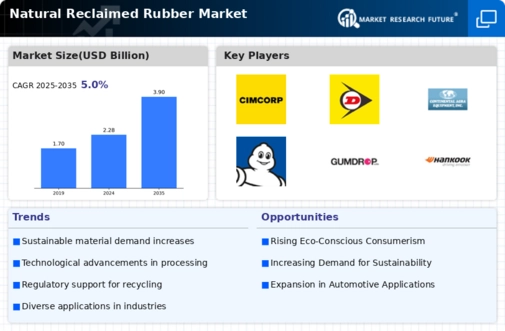Regulatory Support
Regulatory support is a significant driver for the Global Natural Reclaimed Rubber Market Industry, as governments worldwide implement policies that encourage the use of reclaimed materials. Initiatives aimed at reducing waste and promoting recycling have led to favorable regulations for reclaimed rubber usage in various applications, including automotive and construction. For instance, some countries offer incentives for manufacturers who utilize reclaimed rubber in their products, thereby stimulating market growth. This supportive regulatory environment is expected to sustain a compound annual growth rate of 4.99% from 2025 to 2035, further solidifying the industry's position in the global market.
Market Diversification
Market diversification is emerging as a crucial factor in the Global Natural Reclaimed Rubber Market Industry, as businesses explore new applications for reclaimed rubber beyond traditional uses. Industries such as construction, footwear, and consumer goods are increasingly adopting reclaimed rubber for its durability and cost-effectiveness. This diversification not only opens new revenue streams for manufacturers but also enhances the overall market potential. As companies innovate and expand their product offerings, the market is likely to experience robust growth, with a forecasted increase to 2.28 USD Billion in 2024, driven by these new opportunities.
Growing Automotive Sector
The growing automotive sector is a key driver of the Global Natural Reclaimed Rubber Market Industry, as the demand for tires and other rubber components continues to rise. With the automotive industry increasingly focusing on sustainability, manufacturers are turning to reclaimed rubber to meet both performance and environmental standards. This trend is evident in the production of eco-friendly tires that incorporate reclaimed rubber, appealing to consumers seeking sustainable options. As the automotive sector expands, the market for natural reclaimed rubber is expected to flourish, contributing to the projected growth to 3.9 USD Billion by 2035.
Market Growth Projections
The Global Natural Reclaimed Rubber Market Industry is poised for substantial growth, with projections indicating a rise from 2.28 USD Billion in 2024 to 3.9 USD Billion by 2035. This growth trajectory suggests a compound annual growth rate of 4.99% from 2025 to 2035, reflecting increasing demand for sustainable rubber solutions across various sectors. The market's expansion is driven by factors such as technological advancements, regulatory support, and the growing automotive sector, which collectively enhance the appeal of reclaimed rubber. These projections underscore the industry's potential to adapt and thrive in a rapidly evolving global landscape.
Sustainability Initiatives
The Global Natural Reclaimed Rubber Market Industry is increasingly driven by sustainability initiatives as manufacturers seek eco-friendly alternatives to traditional rubber. The rising awareness of environmental issues has prompted companies to adopt reclaimed rubber, which reduces waste and promotes recycling. For instance, major tire manufacturers are incorporating reclaimed rubber into their products, thereby decreasing their carbon footprint. This shift not only aligns with global sustainability goals but also appeals to environmentally conscious consumers. As a result, the market is projected to reach 2.28 USD Billion in 2024, reflecting a growing commitment to sustainable practices in the rubber industry.
Technological Advancements
Technological advancements play a pivotal role in the Global Natural Reclaimed Rubber Market Industry, enhancing the efficiency of reclaimed rubber production processes. Innovations in processing techniques and machinery have improved the quality and performance of reclaimed rubber, making it a viable alternative to virgin rubber. For example, advancements in devulcanization technology allow for better recovery of rubber properties, thus expanding its applications across various sectors. This trend is likely to contribute to the market's growth, with projections indicating a rise to 3.9 USD Billion by 2035, as manufacturers increasingly adopt these technologies to meet rising demand.



















Leave a Comment